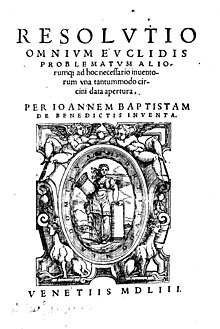Giambattista Benedetti
Giambattista Benedetti | |
|---|---|
| Born | 14 August 1530 |
| Died | 20 January 1590 (aged 59) |
| Scientific career | |
| Fields | Mathematician |
Giambattista (Gianbattista) Benedetti (14 August 1530 – 20 January 1590) was an Italian mathematician from Venice who was also interested in physics, mechanics, the construction of sundials, and the science of music.[1]

Science of motion
In his works Resolutio omnium Euclidis problematum (1553)[2] and Demonstratio proportionum motuum localium (1554),[3] Benedetti proposed a new doctrine of the speed of bodies in free fall. The accepted Aristotelian doctrine at that time was that the speed of a freely falling body is directly proportional to the total weight of the body and inversely proportional to the density of the medium. Benedetti's view was that the speed depends on just the difference between the specific gravity of the body and that of the medium. As opposed to the Aristotelian theory, his theory predicts that two objects of the same material but of different weights would fall at the same speed, and also that objects of different materials in a vacuum would fall at different though finite speeds.[1][4]
In a second edition of the Demonstratio (also 1554), he extended this theory to include the effect of the resistance of the medium, which he said was proportional to the cross section or the surface area of the body. Thus two objects of the same material but of different surface areas would only fall at equal speeds in a vacuum. He repeated this version of his theory in his later Diversarum speculationum mathematicarum et physicarum liber (1585). In this work he explains his theory in terms of the then current theory of impetus.[1][4]
It is thought that
In 1562, the
Music
In a letter to
Centuries later,
Works

- De gnomonum umbrarumque solarium usu (in Latin). Torino: eredi Niccolò Bevilacqua. 1574.
- Consideratione d'intorno al discorso della grandezza della terra, e dell'acqua (in Italian). Torino: eredi Niccolò Bevilacqua. 1579.
- Diversarum speculationum mathematicarum et physicarum liber (in Latin). Torino: eredi Niccolò Bevilacqua. 1585.
- Demonstratio proportionum (in Italian). Venezia: Istituto veneto di scienze lettere ed arti. 1985.
References
- ^ a b c "Benedetti, Giovanni Battista". The Archimedes Project. Archived from the original on 2012-02-20. Retrieved 2010-03-11.
- ^ Resolvtio Omnivm Euclidis Problematvm aliorvmque ad hoc necessario inuentorum una tantummodo circini data apertura. Per Ioannem Baptistam de Benedictis Inventa (Venetiis, 1553). Page views at Internet Archive.
- ^ Demonstratio Proportionum Motuum Localium contra Aristotelem et Omnes Philosophos. Per Ioannem Baptistam de Benedictis inuenta (Venetiis, 1554 Idibus Februarii). Page views at Internet Archive.
- ^ S2CID 144883728.
- ISBN 978-0-521-58841-6.
- ^ J. Taisnier, Opusculum perpetua memoria dignissimum, de natura magnetis et ejus effectibus, Item de motu continuo (Apud Joannem Birckmannum, Cologne 1562). Pageviews at Google.
- ^ Duhem, Pierre (1911). "Pierre de Maricourt". The Catholic Encyclopedia. Vol. 12. New York: Robert Appleton Company.
- ISBN 978-0-684-16424-3.
- ^ Tenney, James (1983). "John Cage and the Theory of Harmony" (PDF). p. 24.

